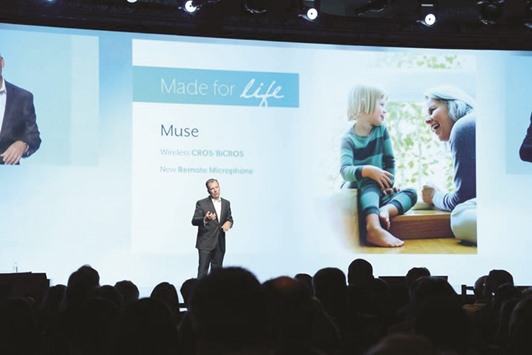After three years and millions of dollars, Starkey Hearing Technologies recently unveiled a next-generation hearing aid that promises to channel both realistic speech and authentic-sounding music to the hard of hearing.
Officials of the Minneapolis-area manufacturer said their new Muse hearing aid uses separate “signal processors” for the first time. They are banking on it to be a hit with baby boomers, veterans and others who will not be separated from their music even as they age and lose some ability to hear.
While hearing aids have long helped convey speech, the task of relaying authentic-sounding music has proved elusive. The complex range of quickly shifting frequencies and gyrating combinations of bass, midrange and treble have made music hard to capture realistically.
“But we refused to accept that music can’t sound good,” said David Fabry, Starkey vice president of audiology and professional relations.
That determination paid off. In January, Starkey introduced its wireless Muse hearing aid and four other “Made For Life” hearing products during the Starkey Expo in Las Vegas.
In March, the company brought Muse and its other high-tech products to audiology customers in South Africa, New Zealand and Australia. In mid-April, the products head to the American Academy of Audiologists conference in Phoenix and then to the Department of Veterans Affairs in May.
About 500 researchers and product developers worked on the new hearing aids. The company worked with musicians and focus groups to make sure the device captured music in a full-bodied way, said officials.
Fabry declined to discuss Muse’s market potential but said it is “significant” because it brings a level of technology to the industry that is not currently available.
“This is a milestone for us,” Fabry said. “We certainly expect this to contribute to the bottom line.”
The new high-definition Muse is wireless and models either fit behind the ear, sit visibly inside the ear or hide invisibly inside the ear canal. Prices range from $1,500 to $3,000 per ear.
Muse uses more powerful microchips than in the past and new software that allows users to seamlessly hear words and music, whether they are on a smartphone or Blue Tooth device or listening to iTunes, a live concert or conversations in quiet libraries or noisy restaurants.
The device employs Starkey’s new 900sync wireless technology, Synergy hardware platform and Acuity operating software to process multiple sounds simultaneously. It lets audiologists custom fit patients by adjusting 24 channels or bands and can synchronise sounds entering the ears of a patient wearing two very different hearing aids.
“I’m excited to fit my first patient with these,” said Stephanie Rogers, head audiologist for Audibel Hearing Healthcare’s 10 stores in Mississippi and Alabama. She trained to use the devices at Starkey’s headquarters and likes what she saw. Muse’s bandwidth is 10,000 hertz, compared to the old 6,000 to 8,000 hertz limits of Starkey’s past products.
“This will help my patients get that full music sound,” Rogers said. “My patients with high frequency hearing loss often complain that they can’t hear the lyrics in the music or vice versa. Or that the music sounds flat. It’s an area we are always battling and asking how can we make music more pleasant.”
The new technology is allowing more flexibility in Starkey products and could be a hit among her ageing baby boomer patients who are beginning to experience hearing loss, and who refuse to be separated from their music, she said.
The timing is perfect, Fabry said.
About 8,000 baby boomers are turning 70 every day, according to AARP.
That means the market is expanding, Fabry said.
Besides Muse, Starkey launched its iPhone-compatible “Halo 2” device, new tinnitus controls and a new wireless “SurfLink” remote microphone that lets hearing aid users zero in on speeches even during noisy conventions and seminars.
The fresh investments are expected to help Starkey, which has been accused by some in the industry of lagging behind its European rivals in technology developments.
The company recently dropped from the second-place to third-place supplier for the Department of Veterans Affairs. Officials hope the new updates will change that.
“One of the most significant aspects of this platform is that we built it to optimise sound quality for both music and for speech, which are both critical hearing environments,” Fabry said.
“It is a very significant attribute.”
Starkey has been through much turmoil in the past year, with a mass firing of several executives and ensuing legal battles. The company has maintained that it has the talent to move ahead despite the challenges associated with the turnover. —Star Tribune (Minneapolis)/TNS

RINGING IN THE NEW: A new Starkey hearing aid called the Muse is designed to bring full music sound to the ears of baby boomers and others.


